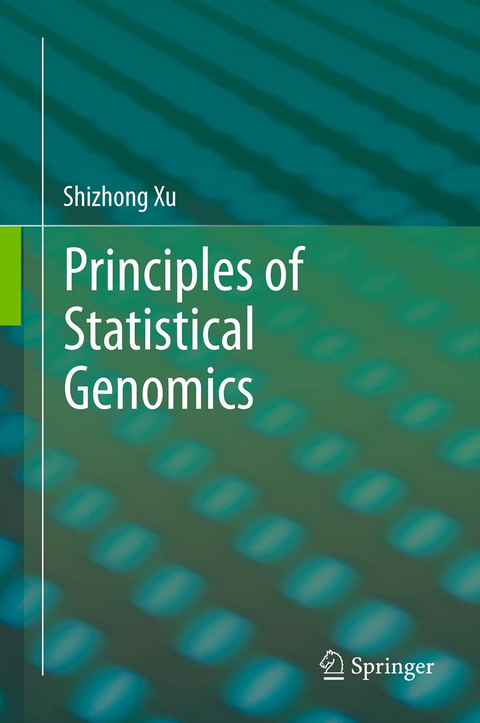
Principles of Statistical Genomics
Springer-Verlag New York Inc.
978-1-4899-9404-2 (ISBN)
Statistical genomics is a rapidly developing field, with more and more people involved in this area. However, a lack of synthetic reference books and textbooks in statistical genomics has become a major hurdle on the development of the field. Although many books have been published recently in bioinformatics, most of them emphasize DNA sequence analysis under a deterministic approach.
Principles of Statistical Genomics synthesizes the state-of-the-art statistical methodologies (stochastic approaches) applied to genome study. It facilitates understanding of the statistical models and methods behind the major bioinformatics software packages, which will help researchers choose the optimal algorithm to analyze their data and better interpret the results of their analyses. Understanding existing statistical models and algorithms assists researchers to develop improved statistical methods to extract maximum information from their data.
Resourceful and easy to use,Principles of Statistical Genomics is a comprehensive reference for researchers and graduate students studying statistical genomics.
Shizhong Xu, PhD University of California, Department of Botany and Plant Sciences, Riverside, CA, USA
Genetic Linkage Map.- Map Functions.- Physical map and genetic map.- Derivation of map functions.- Haldane map function.- Kosambi map function.- Recombination Fraction.- Mating designs.- Maximum likelihood estimation of recombination fraction.- Standard error and significance test.- Fisher’s scoring algorithm for estimating.- EM algorithm for estimating.- Genetic Map Construction.- Criteria of optimality.- Search algorithms.- Exhaustive search.- Heuristic search.- Simulated annealing.- Branch and bound.- Bootstrap confidence of a map.- Multipoint Analysis of Mendelian Loci.- Joint distribution of multiple locus genotype.- BC design.- F2 design.- Four-way cross design.- Incomplete genotype information.- Partially informative genotype.- BC and F2 are special cases of FW.- Dominance and missing markers.- Conditional probability of a missing marker genotype.- Joint estimation of recombination fractions.- Multipoint analysis for m markers.- Map construction with unknown recombination fractions.- Basic Concepts of Quantitative Genetics.- Gene frequency and genotype frequency.- Genetic effects and genetic variance.- Average effect of allelic substitution.- Genetic variance components.- Heritability.- An F2 family is in Hardy-Weinberg equilibrium.- Major Gene Detection.- Estimation of major gene effect.- BC design.- F2 design.- Hypothesis tests.- BC design.- F2 design.- Scale of the genotype indicator variable.- Statistical power.- Type I error and statistical power.- Wald-test statistic.- Size of a major gene.- Relationship between W-test and Z-test.- Extension to dominance effect.- Segregation Analysis.- Gaussian mixture distribution.- EM algorithm.- Closed form solution.- EM steps.- Derivation of the EM algorithm.- Proof of the EM algorithm.- Hypothesis tests.- Variances of estimated parameters.- Estimation of the mixing proportions.- Genome Scanning for Quantitative Trait Loci .- The mouse data.- Genome scanning.- Missing genotypes.- Test statistics.- Bonferroni correction.- Permutation test.- Piepho’s approximate critical value.- Theoretical consideration.- Interval Mapping.- Least squares method.- Weighted least squares.- Fisher scoring.- Maximum likelihood method.- EM algorithm.- Variance-covariance matrix of ˆθ.- Hypothesis test.- Remarks on the four methods of interval mapping.- Interval Mapping for Ordinal Traits.- Generalized linear model.- ML under homogeneous variance.- ML under heterogeneous variance.- ML under mixture distribution.- ML via the EM algorithm.- Logistic analysis.- Example.- Mapping Segregation Distortion Loci.- Probabilistic model.- The EM Algorithm.- Hypothesis test.- Variance matrix of the estimated parameters.- Selection coefficient and dominance.- Liability model.- EM algorithm.- Variance matrix of estimated parameters.- Hypothesis test.- Mapping QTL under segregation distortion.- Joint likelihood function.- EM algorithm.- Variance-covariance matrix of estimated parameters.- Hypothesis tests.- Example.- QTL Mapping inOther Populations.- Recombinant inbred lines.- Double haploids.- Four-way crosses.- Full-sib family.- F2 population derived from outbreds.- Example.- Random Model Approach to QTL Mapping.- Identity-by-descent (IBD).- Random effect genetic model.- Sib-pair regression.- Maximum likelihood estimation.- EM algorithm.- EM algorithm under singular value decomposition.- Multiple siblings.- Estimating the IBD value for a marker.- Multipoint method for estimating the IBD value.- Genome scanning and hypothesis tests.- Multiple QTL model.- Complex pedigree analysis.- Mapping QTL for Multiple Traits.- Multivariate model.- EM algorithm for parameter estimation.- Hypothesis tests.- Variance matrix of estimated parameters.- Derivation of the EM algorithm.- Example.- Bayesian Multiple QTL Mapping.- Bayesian regression analysis.- Markov chain Monte Carlo.- Mapping multiple QTL.- Multiple QTL model.- Prior, likelihood and posterior.- Summary of the MCMC process.- Post MCMC analysis.- Alternative methods of Bayesian mapping.- Reversible jump MCMC.- Stochastic search variable selection.- Lasso and Bayesian Lasso.- Example: Arabidopsis data.- Empirical Bayesian QTL Mapping.- Classical mixed model.- Simultaneous updating for matrix G.- Coordinate descent method.- Block coordinate descent method.- Bayesian estimates of QTL effects.- Hierarchical mixed model.- Inverse chi-square prior.- Exponential prior.- Dealing with sparse models.- Infinitesimal model for whole genome sequence data.- Data trimming.- Concept of continuous genome.- Example: Simulated data.- Microarray Differential Expression Analysis.- Data preparation.- Data transformation.- Data normalization.- F-test and t-test.- Type I error and false discovery rate.- Selection of differentially expressed genes.- Permutation test.- Selecting genes by controlling FDR.- Problems of the previous methods.- Regularized t-test.- General linear model.- Fixed model approach.- Random model approach.- Hierarchical Clustering of Microarray Data.- Distance matrix.- UPGMA.- Neighbor joining.- Principle of neighbor joining.- Computational algorithm.- Other methods.- Bootstrap confidence.- Model-Based Clustering of Microarray Data.- Cluster analysis with the K-means method.- Cluster analysis under Gaussian mixture.- Multivariate Gaussian distribution.- Mixture distribution.- The EM algorithm.- Supervised cluster analysis.- Semi-supervised cluster analysis.- Inferring the number of clusters.- Microarray experiments with replications.- Gene Specific Analysis of Variances.- General linear model.- The SEM algorithm.- Hypothesis testing.- Factor Analysis of Microarray Data.- Background of factor analysis.- Linear model of latent factors.- EM algorithm.- Number of factors.- Cluster analysis.- Differential expression analysis.- MCMC algorithm.- Classification of Tissue Samples Using Microarrays.- Logistic regression.- Penalized logistic regression.- The coordinate descent algorithm.- Cross validation.- Prediction of disease outcome.- Multiple category classification.- Time-Course Microarray Data Analysis.- Gene expression profiles.- Orthogonal polynomial.- B-spline.- Mixed effect model.- Mixture mixed model.- EM algorithm.- Best linear unbiased prediction.- SEM algorithm.- Monte Carlo sampling.- SEM steps.- Quantitative Trait Associated Microarray Data Analysis.- Linear association.- Linear model.- Cluster analysis.- Three-cluster analysis.- Differential expres.- SEM algorithm.- MCMC algorithm.- Joint analysis of all markers.- Multiple eQTL model.- SEM algorithm.- MCMC algorithm.- Hierarchical evolutionary stochastic search (HESS).
| Erscheint lt. Verlag | 15.10.2014 |
|---|---|
| Zusatzinfo | XVI, 428 p. |
| Verlagsort | New York |
| Sprache | englisch |
| Maße | 155 x 235 mm |
| Themenwelt | Informatik ► Weitere Themen ► Bioinformatik |
| Naturwissenschaften ► Biologie ► Botanik | |
| Naturwissenschaften ► Biologie ► Genetik / Molekularbiologie | |
| Naturwissenschaften ► Biologie ► Zoologie | |
| ISBN-10 | 1-4899-9404-1 / 1489994041 |
| ISBN-13 | 978-1-4899-9404-2 / 9781489994042 |
| Zustand | Neuware |
| Haben Sie eine Frage zum Produkt? |
aus dem Bereich


